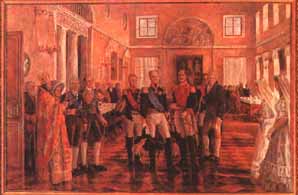[RUSSIAN VERSION]
 | The Alms-house of count N. Sheremetev |
This building is known for lots of people. It is considered a masterpiece of Russian architecture and a beautiful model of Russian classicism of the late 18th - the early 19th cent. It resembles a palace in the form of a semi-horseshoe faced Sadovo-Spasskaya Street not far from the old Sukharevskaya Square.
The first stone of the Alms-house was laid by count N. Sheremetev ( 1751

A copy of a portrait
of countess
Praskovya Sheremeteva |

A portrait of count
N.P. Sheremetev |
-1809) in 1792. Brass memorial table found during excavations works is in Medical Museum now.
The original design was fulfilled by Moscow architect Elizvoi Nazarov. The usual plan of an urban estate of that time was used - a main building situated far from the street, and a park and a garden behind the building.
Having decided to transform the Alms'house into the monument to his died prematurely wife in 1803 Sheremetev drew one of the best Russian architects of that time Giakomo Gvarengi (1744-1817) into the work. On the place of the main entrance he put a double semi-circular open collonade-semirotunda instead of the double-columned severe portico. Creative intervention of Gvarengi also touched interior of the church: he designed a detour gallery. Also Gvarengi designed four annexes - Sukharesky, Saviour's, Keeper's, and Doctor's. The architectural ensemble the Alms-house completed by 1807 was recognized as the work of two architects - Russian Nazarov and Italian Gvarengi who showed a model of creative cooperation.

Dominico Scotti
composition
"Three Incarnate Divinity in Glory"
|
Pictures in the temple were made by Dominico Scotti. Cupola composition "Three Incarnate Divinity in Glory" is of particular expressiveness. In the lower part of the picture one can discern inscription in Latin "Dominico Scotti invented and painted in 1805". By legend little D.Sheremetev was painted as one of the angels (with palm-branch). There is a supposition that the angel with a tambourine is an image of P. Sheremeteva.
Two stately high reliefs on the walls of the temple "Lazarus Resurrection from the Dead" and "Killing of Babies by Herod the King" were made by sculptor academician G. Zamaraev.
Official opening-day took place in a year and a half after the death of the founder. It was timed by his birthday - 28th of June 1810. The event coinsided with the other memorable date in the life of the Russians - hundredth anniversary of the battle near Poltava. B. Sheremetev, the famous Russian general and diplomat and comrade-in-arms of Emperor Peter the Great, was a hero of the battle.
The Alms-house complex was planned for 150 persons: the alms-house in itself (the left wing of the house) for 100 almspersons (50 men and 50 women) and a hospital in the right wing of the house for 50 patients. Alms-house wing was ended with a stately two-storey dining hall.

Phisicians worked in
the Alms-house |
Charitable activity of the Alms-house complex did not ended to the almshouse and the hospital. Annual amount of money granted for poor fiancees, families in need, poor craftsmen, orphans, prisoners, contributions to temples, libraries, funeral of the poor, etc.
More than 200 thousand persons received help there. The hospital of the Alms-house (later it was named Sheremetev's hospital) played an important part in medical aid for poor Muscovites and organizing medical education system.
Many famous medical figures worked in the Sheremetev's hospital (professors of Moscow Medical-Surgical Academy Ya. Kir, P. Kildushevsky, B. Milghausen). The wonderful house went through wars, revolutions, terrible epidemics. During the war of 1812 it was on fire and was seriously broken but owing to keepers, trustees, and philanthropists, like Fenix the bird, was revived from ashes to do its good mission again.
In 1923 Sheremetev's hospital was reorganized into N. Sklifosovsky Firs) Aid Institute. The most brilliant period ir history of the Institute was connected with the activity of outstanding surgeon academician S. Yudin (1891-1954).

A memorial hall
of S. Yudin |
All-round reconstruction of the en semble Alms-house was begun in 198( when Central Medical Museum occupied the building. In 1991 Museum was transformed into the Scientific Research Center "Medical Museum" of the Russian Academy of Medical Sciences. Nov there are tens of thousands exhibits ii Museum and it is the leading Russian center for history of medicine, health and mercy. A number of interesting exhibitions are in Museum (medicine ii Europe in the Middle Ages, history o charity in Russia, medical posters of 20th cent., history of X-ray, application o computers in health, space and radiology medicine, activities of research centers and also memorial rooms of out standing scientists - S. Botkin, S. Yudin P. Anokhin, A. Speransky, 1. Davydovsky)
Also the Russian Center of Mercy and the publishing house "Meditsina i Miloserdije" ("Medicine and Mercy") are now in the Alms-house.
 Mercy like living thread entwines in activity and name of the Sheremetevs' palace again, and the name of the founder sounds on equal terms with reviving All-Russian center of Mercy.
Mercy like living thread entwines in activity and name of the Sheremetevs' palace again, and the name of the founder sounds on equal terms with reviving All-Russian center of Mercy.
Although slowly but reviving of soul Russia is still progressing. It is witnessed with arising charitable organizations and movements, funds of mercy and the Russian center of mercy closely cooperates with these organizations. For short time members of many charitable organizations from Germany, England Italy, USA, Austria had visited Medical Museum.
At the same time restoration works on a large scale are being made and little by little the architectural complex is finding its original face. The Alms-house being "the palladium of Russian charity" is reviving and soon the house of mercy built by N. Sheremetev again will find its past glory that is worthy of the capital of Russia.
Address of museum: 3, Sukharevskaya Sq.
Tel.: (095) 921-08-06
Fax: (095) 975-22-40
| 

